Trust Recovery Growth Vitalization - Marubeni
Trust Recovery Growth Vitalization - Marubeni
Trust Recovery Growth Vitalization - Marubeni
You also want an ePaper? Increase the reach of your titles
YUMPU automatically turns print PDFs into web optimized ePapers that Google loves.
Management’s Discussion and Analysis of Financial Position and Business Results<br />
l. Laws and regulations<br />
In the course of operations, <strong>Marubeni</strong> and its consolidated<br />
subsidiaries are subject to a broad range of laws and regulations<br />
both in Japan and other applicable countries. Changes in or<br />
unanticipated interpretations of these laws and regulations could<br />
increase the obligations pertaining to legal and regulatory<br />
compliance placed on <strong>Marubeni</strong> and its consolidated subsidiaries.<br />
Accordingly, changes or altered interpretations of laws and<br />
regulations may result in punitive measures, including the<br />
interruption of <strong>Marubeni</strong>’s operating activities, lower the<br />
Company’s credibility or cause the occurrence of other circumstances<br />
that could adversely impact the Company’s business<br />
results or financial conditions.<br />
m. Significant litigation<br />
In the course of business activities in Japan and overseas,<br />
<strong>Marubeni</strong> and its consolidated subsidiaries may be party to<br />
litigation, disputes and other legal proceedings. When party to<br />
such litigation, predicting the outcome is impossible given the<br />
inherent uncertainty of these matters. The Company cannot<br />
guarantee that such litigation will not adversely affect the<br />
business results and financial condition of <strong>Marubeni</strong> and its<br />
consolidated subsidiaries.<br />
n. Other risks inherent and related to overall <strong>Marubeni</strong><br />
operations<br />
Negligence on the part of employees charged with executing<br />
business operations, and malfunctions pertaining to computer<br />
systems supporting business activities are among the other risks<br />
that may adversely affect the business results and financial<br />
condition of <strong>Marubeni</strong> and its consolidated subsidiaries.<br />
(2) Risk Management<br />
<strong>Marubeni</strong> and its consolidated subsidiaries operate an integrated<br />
decision-making process, which is deployed when assessing the<br />
provision of credit facilities, investments and other key matters<br />
on a case-by-case basis. When investigating new business<br />
opportunities and other important projects, the <strong>Marubeni</strong> Group<br />
is obligated to report regularly to the Corporate Management<br />
Committee and similar management bodies, and this duty is<br />
reflected in related decision-making. In this way, the <strong>Marubeni</strong><br />
Group seeks to circumvent risks by enhancing risk management<br />
on a case-by-case basis.<br />
With a view to mitigating risk company-wide, the <strong>Marubeni</strong><br />
Group has an integrated risk management system in place to<br />
ascertain a range of quantifiable or measurable risks. Examples<br />
include market, credit and investment risks associated with<br />
specific countries, business formats, and customers. In this<br />
integrated system, fundamental risk management policies and<br />
internal regulations are formulated to ensure proper decisionmaking<br />
and monitoring of these risks. Likewise, organizations,<br />
management systems, management options and systems<br />
infrastructure are also kept in place for executing these policies<br />
and regulations.<br />
For compliance risk and other difficult to quantify or immeasurable<br />
risks, the <strong>Marubeni</strong> Group strives to prevent these risks<br />
systemically by enhancing corporate governance, putting internal<br />
control systems in place and bolstering its compliance structure.<br />
Nevertheless, numerous risks can arise during the course of<br />
the wide-ranging operations of <strong>Marubeni</strong> and its consolidated<br />
subsidiaries. Moreover, the risk management framework operated<br />
by the <strong>Marubeni</strong> Group may be unable to prevent the occurrence<br />
of a variety of risks that carry the possibility of future occurrence.<br />
As a result, the <strong>Marubeni</strong> Group cannot guarantee its ability to<br />
completely manage such risks.<br />
(3) The New Medium-term Management Plan<br />
<strong>Marubeni</strong> and its consolidated subsidiaries embarked on a threeyear<br />
medium-term management plan, the “V” PLAN, from April<br />
2003. With the goal of improving <strong>Marubeni</strong>’s financial position and<br />
strengthening its earnings base, the plan aims to achieve<br />
consolidated net income of ¥50.0 billion, consolidated net interestbearing<br />
debt of ¥2 trillion or less, and a net D/E ratio of 5 times or<br />
less by the fiscal year ending March 31, 2006. However, these<br />
objectives were prepared based on certain assumptions, hypotheses<br />
and projections regarding the persistence of certain economic<br />
conditions, industry trends, and other concerns. A number<br />
of unknown and uncontrollable factors could prevent the Company<br />
from achieving these objectives.<br />
(4) Uncertainty Regarding Financial Condition and<br />
Changes in Operating Results<br />
Factors that have caused the performance and financial condition<br />
of <strong>Marubeni</strong> and its consolidated subsidiaries to fluctuate in the<br />
past include the following items: gains and losses on the sale of<br />
real estate and devaluation losses pertaining to real estate;


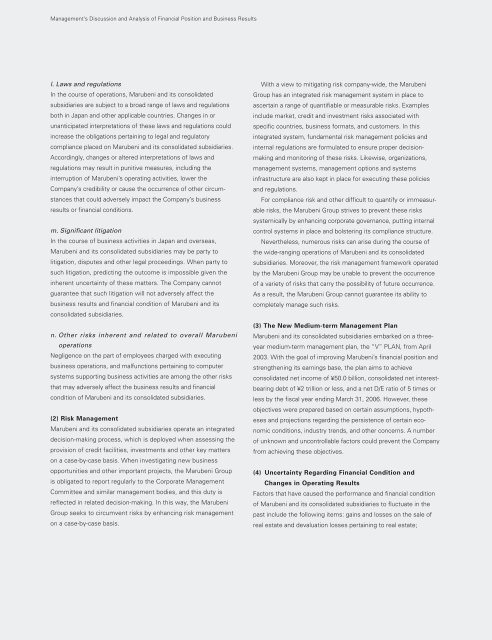
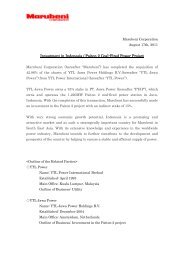
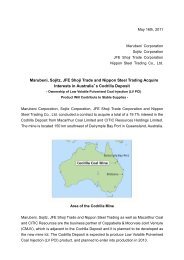
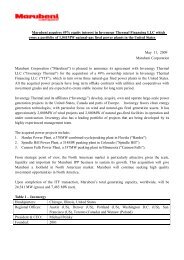

![[Chapter 2] Driving Growth: Expansion Under SG-12 - Marubeni](https://img.yumpu.com/4161147/1/190x248/chapter-2-driving-growth-expansion-under-sg-12-marubeni.jpg?quality=85)


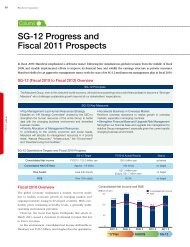

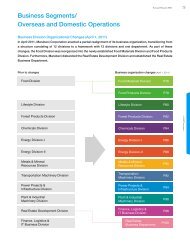
![[Chapter 4] Delivering Growth - Marubeni](https://img.yumpu.com/3464783/1/190x248/chapter-4-delivering-growth-marubeni.jpg?quality=85)


